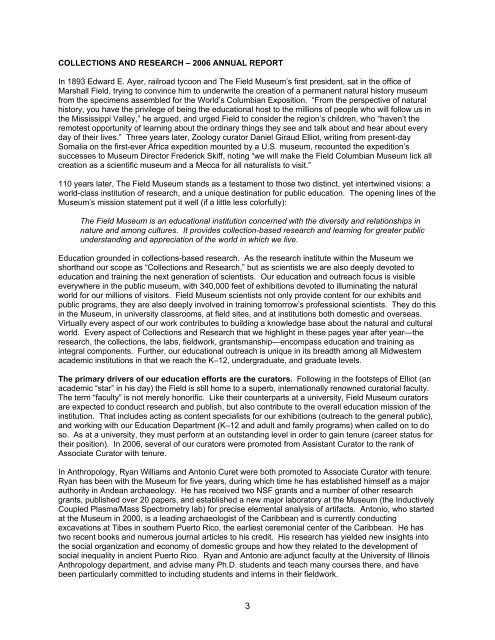2006-2007 - The Field Museum
2006-2007 - The Field Museum
2006-2007 - The Field Museum
You also want an ePaper? Increase the reach of your titles
YUMPU automatically turns print PDFs into web optimized ePapers that Google loves.
COLLECTIONS AND RESEARCH – <strong>2006</strong> ANNUAL REPORT<br />
In 1893 Edward E. Ayer, railroad tycoon and <strong>The</strong> <strong>Field</strong> <strong>Museum</strong>’s first president, sat in the office of<br />
Marshall <strong>Field</strong>, trying to convince him to underwrite the creation of a permanent natural history museum<br />
from the specimens assembled for the World’s Columbian Exposition. “From the perspective of natural<br />
history, you have the privilege of being the educational host to the millions of people who will follow us in<br />
the Mississippi Valley,” he argued, and urged <strong>Field</strong> to consider the region’s children, who “haven’t the<br />
remotest opportunity of learning about the ordinary things they see and talk about and hear about every<br />
day of their lives.” Three years later, Zoology curator Daniel Giraud Elliot, writing from present-day<br />
Somalia on the first-ever Africa expedition mounted by a U.S. museum, recounted the expedition’s<br />
successes to <strong>Museum</strong> Director Frederick Skiff, noting “we will make the <strong>Field</strong> Columbian <strong>Museum</strong> lick all<br />
creation as a scientific museum and a Mecca for all naturalists to visit.”<br />
110 years later, <strong>The</strong> <strong>Field</strong> <strong>Museum</strong> stands as a testament to those two distinct, yet intertwined visions: a<br />
world-class institution of research, and a unique destination for public education. <strong>The</strong> opening lines of the<br />
<strong>Museum</strong>’s mission statement put it well (if a little less colorfully):<br />
<strong>The</strong> <strong>Field</strong> <strong>Museum</strong> is an educational institution concerned with the diversity and relationships in<br />
nature and among cultures. It provides collection-based research and learning for greater public<br />
understanding and appreciation of the world in which we live.<br />
Education grounded in collections-based research. As the research institute within the <strong>Museum</strong> we<br />
shorthand our scope as “Collections and Research,” but as scientists we are also deeply devoted to<br />
education and training the next generation of scientists. Our education and outreach focus is visible<br />
everywhere in the public museum, with 340,000 feet of exhibitions devoted to illuminating the natural<br />
world for our millions of visitors. <strong>Field</strong> <strong>Museum</strong> scientists not only provide content for our exhibits and<br />
public programs, they are also deeply involved in training tomorrow’s professional scientists. <strong>The</strong>y do this<br />
in the <strong>Museum</strong>, in university classrooms, at field sites, and at institutions both domestic and overseas.<br />
Virtually every aspect of our work contributes to building a knowledge base about the natural and cultural<br />
world. Every aspect of Collections and Research that we highlight in these pages year after year—the<br />
research, the collections, the labs, fieldwork, grantsmanship—encompass education and training as<br />
integral components. Further, our educational outreach is unique in its breadth among all Midwestern<br />
academic institutions in that we reach the K–12, undergraduate, and graduate levels.<br />
<strong>The</strong> primary drivers of our education efforts are the curators. Following in the footsteps of Elliot (an<br />
academic “star” in his day) the <strong>Field</strong> is still home to a superb, internationally renowned curatorial faculty.<br />
<strong>The</strong> term “faculty” is not merely honorific. Like their counterparts at a university, <strong>Field</strong> <strong>Museum</strong> curators<br />
are expected to conduct research and publish, but also contribute to the overall education mission of the<br />
institution. That includes acting as content specialists for our exhibitions (outreach to the general public),<br />
and working with our Education Department (K–12 and adult and family programs) when called on to do<br />
so. As at a university, they must perform at an outstanding level in order to gain tenure (career status for<br />
their position). In <strong>2006</strong>, several of our curators were promoted from Assistant Curator to the rank of<br />
Associate Curator with tenure.<br />
In Anthropology, Ryan Williams and Antonio Curet were both promoted to Associate Curator with tenure.<br />
Ryan has been with the <strong>Museum</strong> for five years, during which time he has established himself as a major<br />
authority in Andean archaeology. He has received two NSF grants and a number of other research<br />
grants, published over 20 papers, and established a new major laboratory at the <strong>Museum</strong> (the Inductively<br />
Coupled Plasma/Mass Spectrometry lab) for precise elemental analysis of artifacts. Antonio, who started<br />
at the <strong>Museum</strong> in 2000, is a leading archaeologist of the Caribbean and is currently conducting<br />
excavations at Tibes in southern Puerto Rico, the earliest ceremonial center of the Caribbean. He has<br />
two recent books and numerous journal articles to his credit. His research has yielded new insights into<br />
the social organization and economy of domestic groups and how they related to the development of<br />
social inequality in ancient Puerto Rico. Ryan and Antonio are adjunct faculty at the University of Illinois<br />
Anthropology department, and advise many Ph.D. students and teach many courses there, and have<br />
been particularly committed to including students and interns in their fieldwork.<br />
3

















